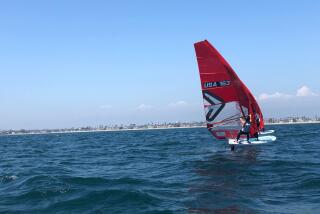The Party-and Race-to Begin, With1 Yacht in a Class by Itself : Champion: Who’s afraid of Virginia? Entrants in the ancient mariner class. The 78-year-old wooden sloop, making a third run in this race, will defend her title.
- Share via
DANA POINT — When the Newport Beach-Ensenada International Yacht Race gets under way today, yachtsmen in modern vessels will start tinkering with high-tech depth gauges, fancy wind-indicator instruments and state-of-the-art digital compasses.
But in the 78-year-old wooden sloop Virginia, the four-man crew will be getting down to old-fashioned seafaring basics.
“We just point her south and let her go,” said her skipper, Daniel Heagney, 46, of Dana Point.
Virginia, making her third trip in the annual Newport Beach-to-Ensenada race, will defend her championship today in the ancient mariner class for older, wooden boats. It is a race made for sailing purists who appreciate boats like Virginia that were designed for speed, not comfort, Heagney said.
“The difference in sailing Virginia and sailing modern boats is striking,” Heagney said. “Modern boats are designed much lighter, much wider and with much less sail area. They float on top of the ocean. Virginia is very narrow and slices through seas, rather than floating over them like a cork.”
Besides being the defending champion, the 44-foot sloop carries an honor no other boat in her class can boast: In February she was included in the National Register of Historic Vessels, a list that includes only the nation’s oldest and most historic boats. Virginia is the only racing sailboat on the West Coast listed in the register.
“She’s a thoroughbred from the past,” Heagney said.
In her nearly eight decades at sea, Virginia has won races on the Atlantic Ocean, Long Island Sound, Lake Michigan, Puget Sound and off the California coast, among other places. Her skipper attributes the long history of victories to the simple design of William Gardner, a design deemed noteworthy enough to win her a place on the registry by the California Department of Fish and Game.
An amalgam of oak frames, mahogany planks and spruce spars, Virginia has seen boats with all sorts of gadgets pass by her bow over the years, but she gets by with more Spartan equipment--two compasses, an old knot meter, a barometer and a weather vane atop her 56 1/2-foot mast.
With the exception of her sails, Virginia is the same boat built 78 years ago. In those days, her canvas sails were made of Egyptian cotton. Today, the sails are made of Dacron.
The sloop’s design became popular in the early 1900s, said Steve Christman, founder of the 10-year-old Nautical Heritage Society. The society is a 3,000-member, nonprofit organization dedicated to preserving the nautical heritage of the Pacific Coast that owns Virginia.
“It was a transition stage in our country’s history and in the history of yachting,” Christman said. “America was coming out of the industrial revolution and, by Virginia’s time, it was beginning to manifest itself into people having spare time, discretionary time for things such as yacht racing. Virginia represents the beginning of the democracy of yachting, when not just the wealthy class could own a sailboat and enjoy the sport of sailing.”
In 1913, when Virginia was built at the Wood & McClure shipyard on City Island, off the borough of the Bronx in New York City, automobiles were a new phenomenon and airplanes were in their infancy.
“It was a time of great exuberance,” Christman said. “It was a time of change in many areas, certainly on the water.”
Virginia and schooners of her ilk represented that change. They were smaller and relatively less expensive, Christman said. Gardner, who died in 1929, created many famous yachts including the schooner Atlantic, which won a race across the Atlantic Ocean in 1905. But it was the performance of his smaller yachts like Virginia that won him fame.
“Virginia was a very innovative, revolutionary design for her time,” Heagney said. “For one thing, she didn’t have any interior to speak of. She wasn’t designed for comfort at all. She was built strictly for racing, very low to the water and much lighter than other boats her size, which made her blazing fast.”
It was in 1925 in the Mackinac Race on Lake Michigan that Virginia made her reputation, Heagney said. It was the most grueling race in the history of the event, with gale-force winds that allowed only eight of 21 boats to finish. Virginia came in first.
Heagney, however, prefers conditions such as those forecast for this weekend--variable winds and breezy.
“We expect to do well with those conditions,” Heagney said. “Virginia’s is a very forgiving design. Whereas modern boats have lots of what we call tweakers--adjustments that must be made--Virginia is easy to sail. With Virginia, if you stick to the basics, she’ll go fast.”
More to Read
Sign up for The Wild
We’ll help you find the best places to hike, bike and run, as well as the perfect silent spots for meditation and yoga.
You may occasionally receive promotional content from the Los Angeles Times.






